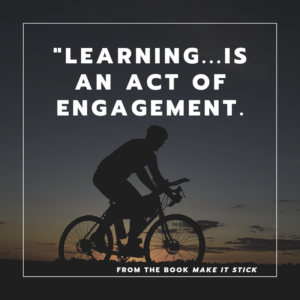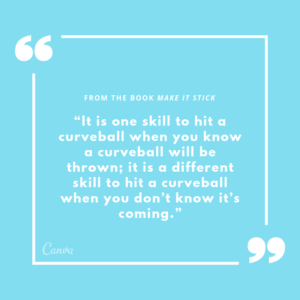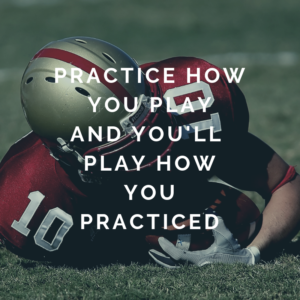In this post:
- A dispelling of some popular educational myths
- Tips to help students discover and activate their studying abilities
- Strategies to make every moment of learning count
- Tips to take directly into your classroom to help students learn more effectively

When my 10 pound baby was born, I realized my first born son had gone his whole life (almost 4 years) without ever saying “I love you.” Not once. Never. Did he feel it? I would think so. But he never said it, and having another baby made me realize that fact.
After a week in the NICU, we brought our baby girl home and my son FINALLY said “I love you!” WOO HOO!
But what changed?
He saw me say I love you to my daughter. I told him and showed him what he needed to do.
He saw an example of what to do and how to do it with another child over and over again.
As teachers, sometimes we don’t realize that we need to explicitly teach things we have done all of our lives. Or perhaps we figured them out so long ago, it never occurs to us that some things need to be taught – and they really really need taught.
As teachers, sometimes we don’t realize that we need to explicitly teach things we have done all of our lives. Share on XFor example:
- “But Mrs. Riley – I studied last night for 6 hours. Why did I get a D?”
- “I didn’t study because the test isn’t until next week.”
- “I don’t remember prime numbers. We learned that years ago.”
My students have said ALL of those things and more! Do your students say those things or something like them? I have heard them for years whether I was teaching Language Arts or Math, 6th grade or 12th grade.
Many students, especially the bright and gifted students, were simply never taught how to study well. After pouring over books this summer authored by leading cognitive psychologists, here are some fundamentals I will use in my classroom this year.

First, we need to get over the myths in education.
- Reading a book or chapter over and over again does not equal learning. Learning is engagement. Many students (and adults) can read a passage over and over and still recall nothing.
- Engage Yourself: Check out the “Penny Test” here – something you may have seen a thousand times, but it is difficult to find the right one!
- Teaching Using Learning Styles yields little growth. This one blew me away! But after years of studies, those intelligences of Gardner’s and visual/spatial/kinesthetic learning styles have become one of those festered myths imaginable. Using different learning styles to teach simply doesn’t help. (What DOES work is a strategy below!)
- Engage Yourself: Even Howard Gardner – father of Intelligences – says there are not “styles.” But it is important to learn a skill in different ways. Gardner’s article can be found here.
Second, here are some ways to make every moment count.
Retrieval: The more often you retrieve information from your brain, the more you will make it stick. How do we teach students to quiz themselves? How do we show them what to do when they get home? Model it in school!
- Pre-quiz: Actually asking students to do a problem before teaching them how to do it improves retention.
- Exit Ticket: Have students take a low stakes quiz (4 questions) at the end of the lesson, or the next day as a bell-ringer. These can include the lesson or – preferably – anything from the previous content. For example, 7th grade Math doesn’t go over prime numbers, but they do those in 4th grade. So you could include prime numbers and help students recall what they learned previously.
- Review or Study Guide 24 hours or more before the exam
- Have students write down 10 things they learned today
- Reflection: What did you learn? How does it relate to what you already know?
- Online sources for quizzing themselves: Quizlet, Kahn Academy, IXL
- Free Recall: On a blank piece of paper, write down everything you can remember from class.
- Group Recall: On Monday, have students illustrate everything they learned the previous week using arrows, bubbles, words, pictures, etc.

Spacing: The act of forgetting and then having to recall information helps it stick.
- Work Backwards: From the day of the exam, work backwards and set up a study schedule. If there is a test in a month, perhaps study once per week and then every other day the week of the test.

Interleaving: Sequencing learning tasks so that similar items are interspersed with different ones.
- Mix up the problems: This goes against almost every math textbook published in the country. Chapters usually do one skill at a time over and over before moving to the next skill. Now, in the short term this does benefit the student. But in the long term, the students that do different kinds of problems at the same time do better on the exam. Why? Usually your exams mix up the problems. Usually the state assessments mix up the problems. Yet students are presented them in order when they are learning. Try mixing them up! For example, instead of doing the volume for a sphere over and over, then the formula for a cylinder, then the prism, and then the pyramid, mix them up and have students decide what formula they need to use.

Practice this in Class
-
-
-
- Ask students a question after 5-10 minutes of lecture. Have them try to answer without looking at their notes.
- Think time: Have students vote on which group answer is correct. They can play 4 corners or hold up fingers. Then, they go find someone in the room with a different answer and try to persuade why their own answer is correct.
- We remember things that are personal and concrete. Connect learning to a personal story. Bring in objects or show objects.
- West Point Academy uses the Thayer Method for teaching which includes 3 main ideas: clear learning objectives, a daily quiz, and active problem solving
-
-
Books for more information that I used for this article:
About Mary Ellen Riley
Hello! I am Mary Ellen, a wife, mother of two, certified K-12 teacher, and crafts and coffee lover. As a mother and teacher of gifted students, I provide practical support throughout my schools for all students who need more depth and enrichment.
Visit Mary Ellen’s Websites:


